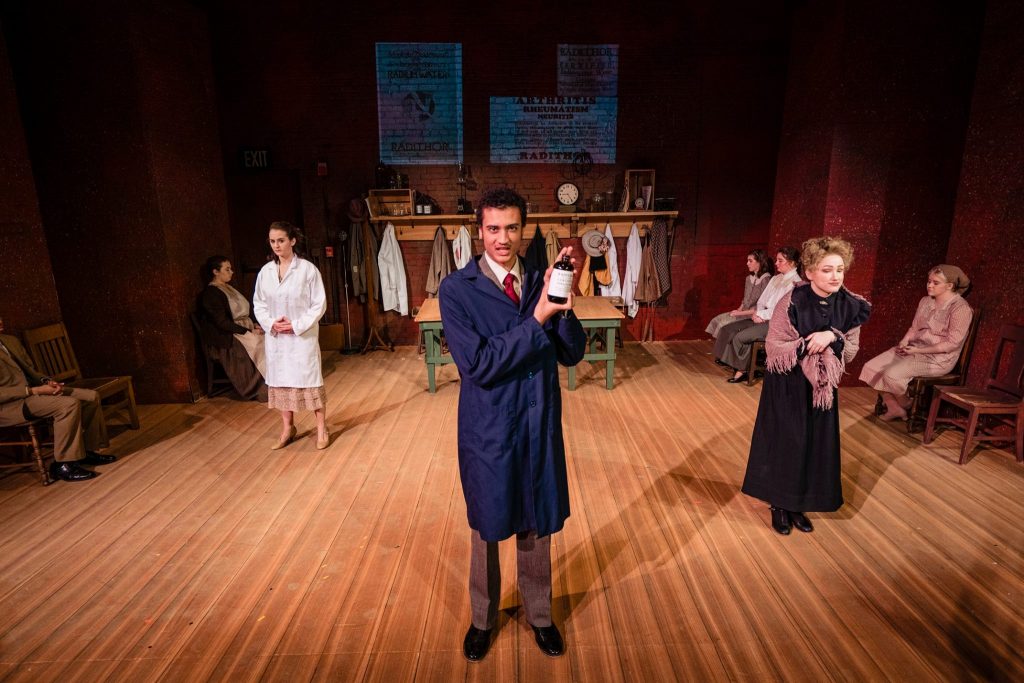
Based on the circumstances of the lawsuit by female watch-painters employed by the United States Radium Corporation against their employers in the 1920-1930s, the emotionally-gripping tragedy of “Radium Girls” was something of a return to form for Jewell Theatre Company (JTC), following the first semester’s pallid performance of “Much Ado About Nothing.”
Just in time for International Women’s Day, “Radium Girls” is a play that explores themes of poverty, class antagonisms, medicine and the role of women in each area.
Like gears in a wristwatch, each actor on stage performed their role seamlessly. A few performances especially stood out – namely those by students Terrace Wyatt Jr, Isaac Chizhik and Emma Mayfield.

Photo courtesy of photos.jewell.edu 
Photo courtesy of photos.jewell.edu
Wyatt and Mayfield tirelessly carry a strong depiction of the relationship between exploiter and exploited – Reeder (Wyatt) attempting to secure his standing and profit by any means, whilst in his extraction of profit from Grace’s (Mayfield) labor, he drains the very life from her as well.
Chizhik portrayed no fewer than four characters, giving each one a distinct style but always recognizably his own. The actor’s transition from one role to another in the final scene had this critic virtually fist-pumping at the change.
Director Chris McCoy sets these performances on the stage with a sort of “neo-Brechtian” flair, upon which no actor ever truly leaves. Named for the stylistic approach of German playwright Bertolt Brecht, one of the driving principles of Brechtian performance is its commitment to remain simply a play – the audience should not be so drawn into the spectacle that they forget it is only that.
At times, the stage setup heightened the anxiety of certain scenes, such as the opening of Act 2, in which a multitude encircle Mayfield to ask about potential settlement money. Sincere in questioning but taunting in their execution, this scene is one of many in which the sustained presence of the actors lends to the audience’s feeling that for the Radium Girls, it is as though the whole world is watching them.
The show was not without its issues, however. Take for example the chemistry between actors Mayfield and Jaimeson Satterfield. Perhaps it was a choice on the actors’ part – with regards to the direction their relationship goes – but their chilly regard for each other early on in the performance has the effect of leaving the audience uninterested from their first scene together.
Additionally, though this may be a problem with the script rather than its interpretation, the dream sequence of Act 2 seems very out of place – it feels completely without stakes. This is likely owing to a script which did not anticipate such a Brechtian interpretation to be applied.
In addition, the lights – which, up until the dream sequence were more realist – take on a surreal quality with the aid of blues and purples. Strangely for a show concerning radium, the dream sequence had very little green. About halfway to being eerie, this viewer was left wondering if it would have made more of an impression had there been traditional scene changes so as to allow for some defamiliarization with the set, rather than repeating the same again and again.
That said, great credit is due to lighting designer Joseph Duncan and the rest of the tech crew – their design choices lent greatly to the at-times claustrophobic nature of the performance, even in the weaker areas of the show.
The projections, additionally, set the scene in a wonderful and gruesome manner. The limitations of academic theatre on JTC’s scale precludes any makeup from properly displaying the kind of medical horrors experienced by the Radium Girls, and so the images projected onto the wall during the pre-show communicate to the audience what the actors, through performance alone, cannot. The projections were useful during scene transitions as well – as visual aids within a scene – and in performance’s ending, which figures as a celebration of some notable women in labor, science and the humanities who have followed in the Radium Girls’ footsteps.

The show’s premiere was timed to the recognition of International Women’s Day, something few today know was started by the women working in the St. Petersburg textile mills in 1917 – a group not unlike the protagonists of “Radium Girls” – indeed, it was originally founded as International Working Women’s Day. The characters’ struggles color our own today, and guarantees the show relevance – living as we are in a world where wealth inequality is soaring, medical costs are skyrocketing and work appears to be slowly killing all of us. This being the case, Jewell Theatre Company shows the audience to never give in, no matter how the public may feel about an “angry woman.”
